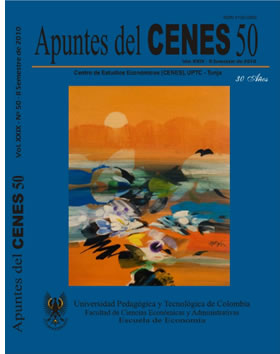Estimation of risk in a portfolio of assets
Keywords:
extreme value theory, copula, value at risk, dependence, returnsAbstract
This paper introduces the use of extreme value theory (EVT) and copula for the estimation of value at risk (VaR) for a three asset portfolio representative of the Colombian market. Returns on risk factors are adjusted by ARMA GARCH models and innovations for each of them are modeled by Pareto’s generalized distribution in order to estimate one-day volatility. Copulas are built on the assumption that innovations follow an empirical marginal distribution so as to represent the dependence structure among risk factors. Performance tests for a series of three month VaR estimations show that modeling volatility and dependence through the use of these theories result more appropriate than those based on normality assumptions.Downloads
References
ARTZNER, Delbaen; Eber, J.; and HEATH, D., (1997), Thinking coherently, Risk 10, 68-71.
BALKEMA, A. y DE HAAN, L., (1974), Residual Lifetime at Great Age, Annals of Probability, 2, 792-804.
BALZAROTTI, V. y DELFINE, M., (2001), Teoría de Valores extremos aplicada a la medición de riesgos de mercado en
Argentina, Documento de Trabajo, Banco Central de Argentina, Argentina.
BECERRA, O. y MELO, L. F., (2008), “Medidas de riesgo financiero usando cópulas: teoría y aplicaciones”, Borradores de Economía, N.o. 489, Banco de la República.
BENSALAH, Y., (2000), “Steps in Applying Extreme Value Theory to Finance: A Review”, Working Paper, Bank of Canada.
CARDOZO, P. (2004). Valor en riesgo de los activos financieros colombianos aplicando la Teoría de Valor Extremo, Artículo realizado como parte de la tesis de la Maestría de Economía, Universidad de los Andes, Bogotá.
CASTAÑO, E. V., (S. F.), Manejo conjunto de riesgos financieros: no todo es Correlación.
CHERUBINI, U.; LUCIANO, E.; y VECCHIATO, W., (2004), “Copula Methods in Finance”, JohnWiley and Sons, New York.
DANIELSON J. and DE VRIES, C., (2000), “Value-at-risk and Extreme Returns”, Annales d’Economie et de Statistique, 60, 239-270.
DANIELSON, J.; HARTMAN, P., and DE VRIES, C., (1998), “The Value of Value at Risk: Statistical, Financial and Regulatory Considerations”, Perspective on Economic Highlights of the Year, 4(3), 2, 107-108, Federal Reserve Bank of New York,
DE LARA, H., (2005), “Medición y control de riesgos financieros”, 3.ª edición, Editorial Limusa.
DIAS, A. and EMBRECHTS, P., (2004), “Dymanic Copula Models for Multivariate High Frecuency Data in Finance”,Working Paper, Departamento de Matemáticas, Zurich: ETH.
EMBRECHTS, P.; MCNEIL, A.; and STRAUMANN, D., (1999), “Correlation: Pitfalls and Alternatives”, Discussion Paper, ETH Zurich.
FERNÁNDEZ, V., (2003), “Extreme Value Theory and Value at Risk”, en Revista de Análisis Económico, Universidad de Chile, Chile.
FREGOSO L. J., (S.F.). Teoría de Portafolios, presentación, Universidad Anáhuac.
GILLI,M. and KELLEZI,M., (2005), “An Application of Extreme Value Theory for Measuring Financial Risk”,Working Paper, University of Geneva and FAME.
GLASSERMAN, P.; HEIDELBERGER, P., and SHAHABUDDIN, P., (2002), “Portfolio Value-At-Risk withHeavy-Tailed Risk Factors”, Mathematical Finance, volume, 12, N.o 3, 239-269
HOSKING, J. and WALLIS, J., (1987), Parameter and Quantile Estimation for the Generalized Pareto Distribution, Technometrics, 29, 339-349.
HOTTA, L.K.; LUCAS, E.C., and PALARO, H.P., (2006), “Estimation of VaR Using Copula and Extreme Value Theory”, Working Paper, ESAMC, Universidad Campinas, Brazil.
MANGANELLI, S. and ENGLE, R., (2001), “Value at RiskModels in Finance”, Working Paper Series, European Central Bank.
McNEIL, A. and FREY, R., (2000), “Estimation of Tail-Related RiskMeasures for Heteroscedastic Financial Time Series: An Extreme Value Approach”, Journal of Empirical Finance, 7, 271-300.
McNEIL, A., (1999), “Extreme Value Theory for Risk Managers”, Working Paper, ETH Zurich.
McNEIL, A.; FREY, R.; and EMBRECHTS, P., (2005), Quantitative Risk Management: Concepts, Techniques, and Tools, Princeton University Press.
MORGAN, J., (1996), Riskmetrics – documento técnico, JP Morgan, Nueva York..
NELSEN, R., (1999),”An Introduction to Copulas”, Inc, Springer-Verlag,NewYork.
ODENING,M. and HINRICHS, J., (1999), Using Extreme Value Theory to Estimate
Value-at-Risk, Humboldt University.
PATTON and ANDREW, J., (2001), Estimation of copula models for times series of possibly different lengths, Universidad de California de San Diego, Economics Working Paper Series, N.o 17.
PICKANDS, J., (1975), Statistical Inference Using Extreme Order Statistics. Annals of
Statistics, 3, 119-131.
QUEVEDO, R., (S. F.), Dependencia entre activos financieros: un ejemplo para la relación Tes–Dólar más allá de los supuestos, Facultad de Economía, Universidad Externado de Colombia, Bogotá.
ROMANO, C., (2003), “Applying Copula Function to Risk Management”, Working Paper. University of Rome “La Sapienza”, Risk Management Function, Rome.
SALINAS, M., (2009), “Estimación del Valor en Riesgo (Var) desde la Teoría de Valor Extremo y Cópulas: aplicación a un portafolio de activos”, Trabajo de Grado.
SUPERINTENDENCIA FINANCIERA DE COLOMBIA, (2003), Circular Básica Contable y Financiera, Capítulo XXI, “Criterios y procedimientos para medición de riesgos de mercado”.
VÉLEZ, Julio, (2007), Teoría de Cópulas aplicada a la predicción, Universidad Complutense de Madrid, Facultad de Ciencias Económicas, Departamento de Estadística e Investigación Operativa, Madrid.
VILLAREAL, J., CRUZ, J.; y ROSILLO, J., (2003), Finanzas corporativas. Valoración, política de financiamiento y riesgo. Teoría y práctica, Thomson.
ZIVOT, E., and WANG, J., (2006), Modeling Financial Time Serieswith S-Plus, Springer.

Downloads
Published
How to Cite
Issue
Section
License
Copyright (c) 2010 Luis Guillermo Díaz, Diana A Maldonado, Sandra Milena Salinas

This work is licensed under a Creative Commons Attribution-NonCommercial-ShareAlike 4.0 International License.





